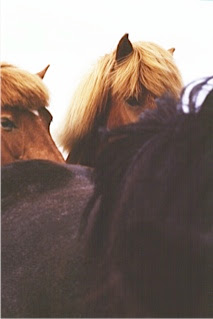A story I read the other day in The Reykjavík Grapevine, “Iceland’s First Gay Lovers,” surprised me by explaining something I had written about many years ago.
In 1997, while researching my
book A Good Horse Has No Color,
I stayed for some weeks at Snorrastadir in the west of Iceland. One afternoon I
listened in as the farmer, Haukur, and another guest, a horsewoman named
Hallgerdur, discussed Njal’s Saga,
the medieval masterpiece that contains a famous “feminist” character also named
Hallgerdur.
Here’s how I described the
scene in my book:
…Known for her hip-length
hair and her “thief’s eyes,” this storied Hallgerdur had been wooed and wed by
the handsome Gunnar of Hlidarendi, that paragon of Icelandic manhood who,
according to the saga, could “jump more than his own height in full armor, and
just as far backwards as forwards.”
“He could swim like a seal,”
the book said.
“There was no sport at which
anyone could even attempt to compete with him.”
“There has never been his
equal.”
The marriage was a disaster.
It ended in Gunnar’s death when, his house surrounded by enemies his wife had
made for him, his bowstring broke and he asked for some strands of her long
hair to plait into a new one; she refused.
 |
| Snorrastadir at midnight. |
It was this that Haukur and
Hallgerdur were discussing: why the Saga-Age Hallgerdur—an historical woman who
lived and died about a thousand years ago—had refused the gift of her hair.
They chattered on too fast
for me to more than snatch at the argument. I marveled again that these sagas,
of esoteric, antiquarian interest at home, were so alive here, centuries after
they were written. I was heading again for that hot cup of tea when Haukur gave
out a great guffaw.
“Er Gunnar á Hlidarendi, nú, hommi?!” he asked. “Is Gunnar of Hlidarendi, now, a
homosexual?”
I stopped. I looked at
Hallgerdur. The answer she was arguing was yes.
You could write a dissertation on that one, I thought—Homosexuality in Njal’s Saga. Gunnar did have an unusually close
friendship with Njal, whose manhood was in question because he couldn’t grow a
beard. I wished I could comprehend the details of Hallgerdur’s thesis and join
in the conversation, but though I’d read the saga several times and knew it
inside out, my spoken Icelandic wasn’t up to the task. I retreated to the
kitchen, where Ingibjorg gracefully drew my attention to the fact that the
dishwasher could be unstacked and the table set for dinner. With the clatter
drowning out Haukur’s increasing outrage, I replayed the point in English in my
head and awarded the set and match to Hallgerdur…
 |
| Snorrastadir and the crater Eldborg. |
That’s what I witnessed in
1997.
I had gone to Iceland first
in 1986, after studying Old Norse for several years—and having been taught that
the language was “dead,” like Latin. As I wrote earlier in this blog
(“Practical Education”),
I was delighted to learn to the contrary on that first visit that Old Norse
wasn’t “dead” after all. It had just shifted into Icelandic, changing about as
much as English has since Shakespeare’s day.
By 1997 (my seventh trip to
Iceland), I knew that the sagas themselves were still very much alive, some 800
years after they had been written. Everywhere I went in Iceland, someone shared
an allusion from a saga. The medieval past was remembered in the name of every
hill and farmstead (not to mention every beer and candybar). There was a saga
everywhere I turned.
What I didn’t know, when I
witnessed Haukur and Hallgerdur arguing over homosexuality in Njal’s Saga, was the news peg.
 |
| Horses at Snorrastadir. |
It’s true that Icelandic
farmers are surprisingly keen readers compared to the farmers I know in America.
Another day I came upon Haukur and a guest comparing the novel Independent People, by Iceland’s Nobel
prize-winner Halldor Laxness, to Growth
of the Soil, by the Norwegian Nobelist, Knut Hamsun.
But Homosexuality in Njal’s Saga was not Hallgerdur’s idea. The
dissertation didn’t need to be written—a book was already in print, as I
learned last week from The Reykjavík Grapevine.
In “Íslenska Kynlífsbókin” (The Icelandic Sex Reader), published in
1990, Óttar Guðmundsson, a psychiatrist at the Landspítali hospital in Reykjavík,
“famously argued that Njáll and Gunnar, heroes of ‘Njáls Saga,’ were gay and in
love with each other,” the Grapevine
says. The newspaper also mentions Óttar’s new book, “Hetjur og hugarvíl” (Anxious Heroes), “devoted to
psychoanalysing the main characters of some of the more prominent Icelandic
Sagas.”
Looks like I have some
further reading to do. And a thank-you letter to send to psychiatrist Óttar Guðmundsson for his help in keeping the Icelandic sagas alive.
Join me again next Wednesday at nancymariebrown.blogspot.com
for another writing adventure in Iceland or the medieval world.

No comments:
Post a Comment